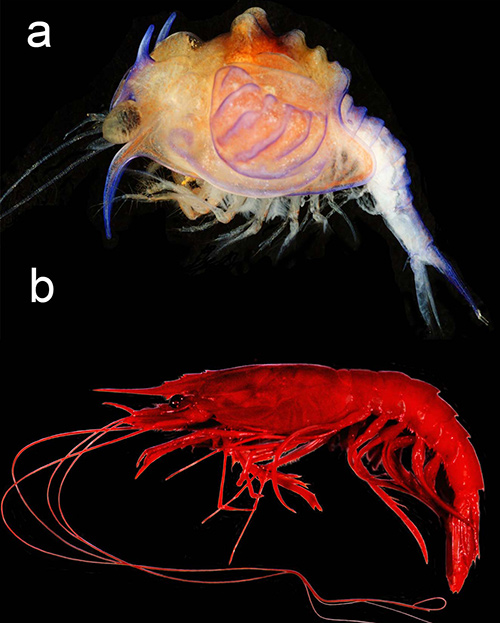
By Heather Bracken-Grissom, Assistant Professor - Department of Biological Sciences, Florida International University-Biscayne Bay Campus
The deep sea (>200 meters; 655 feet) is the largest habitat on Earth and the last unexplored frontier on our planet. It is home to peculiar creatures and mystifying phenomena that appear to live only in science-fiction stories. These animals’ unique physical traits have attracted the interest of many people, including the general public and scientists alike.
As part of this mission to explore some of the deepest waters in the Gulf of Mexico, our team will be working to describe and document some of these novel and bizarre life forms that can only be found in the deep sea. Collection of these animals will be done using mid-water trawling, where we pull a large net behind the boat to collect animals such as small fish, squid, and crustaceans. In some cases, we know exactly what we find when we see it (Bingo!), however, on several occasions we are left scratching our head asking, “What in the world is that!!?”
Mid-water collections commonly include mysterious developmental stages that differ drastically from their adult counterparts in physical appearance and habitat. Unaware of the existence of planktonic larval stages, early scientists often misidentified these unique animals as new adult species. Little did they know these were just bizarre larval forms of many well-known deep-sea animals.
Collecting larvae, raising them in the lab, and identifying the adult forms has allowed several researchers to correctly match larval forms to their adult counterparts. However, challenges arise when the larva is rare or difficult to collect, as is the case for most deep-sea species. In these cases, a technique called DNA barcoding provides a powerful alternative to traditional approaches that depend on rearing of unidentifiable larvae.
DNA barcoding is a molecular technique that can be used to help identify an unknown individual. This requires the use of DNA sequencing to obtain a unique section of DNA that includes enough sequence variation to identify the unknown species. This provides a standardized approach for species identification when traditional taxonomic methods are not possible, for instance due to cryptic species, different life stages, or damaged specimens.
For animals, mitochondrial DNA (mtDNA) became very attractive for the identification of species due to several characteristics, such as generally high substitution rates, large numbers of copies in each cell, and a maternal inheritance pattern. Traditionally, a fragment of the cytochromeoxidase subunit I (COI) gene was proposed as the "DNA barcode" for the identification of animal species more than a decade ago. Today, COI is still used as a DNA barcode along with other mitochondrial genes, such as the large mitochondrial ribosomal subunit, 16S.

Figure A: Cerataspis monstrosa the ‘monster’ larva that has remained unlinked to an adult form for 184 years. [Credit: D. Felder, 2011]
Figure B: Plesiopenaeus armatus the adult form of C. monstrosa [Credit: W. Pequegnat, 1971, female from 3250 m, northwestern Gulf of Mexico]. Taken from Bracken-Grissom et al. 2012, Ecology and Evolution 2012; 2(10): 2367–2373.
Originally described as a “monstrous and misshapen animal,” the bizarre planktonic larva, Cerataspis monstrosa, remained unassigned to an adult counterpart despite nearly two centuries of marine research. This species, first discovered in the gut contents of a dolphin in 1828, is unique in its heavy armor, thick body, and exceptional horn ornamentation (Figure A). In 2012, members from our team successfully used DNA barcoding techniques to definitively link the armored decapod larva, Cerataspis monstrosa, with the deep-sea shrimp, Plesiopenaeus armatus (Figure B).
Larval-adult linkages allow researchers to accurately describe and catalog biodiversity, while also providing information on the distribution, ecology, and life history of a species. For example, linking Cerataspis monstrosa to Plesiopenaeus armatus informed us the larvae typically lived in the midwater ~500 meters (1,500 feet) whereas the adult was found on the seafloor at depths up to 5,000 meters (~15,000 feet)!
Molecular tools provide a powerful alternative to traditional approaches dependent on rearing of otherwise unidentifiable larvae. The combined application of modern DNA techniques with traditional taxonomy will allow us to catalog the new and exciting life forms we discover as part of this expedition.